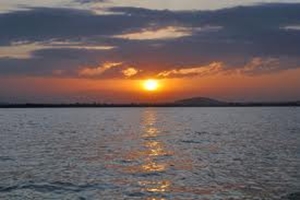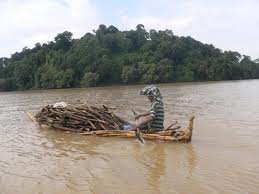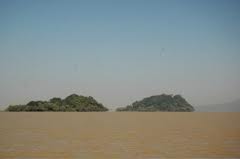
Lake Tana

Rivalling the attraction of the Blue Nile Falls are the thirty-seven islands scattered about on the 3,000-square-kilometre (1,860-square-mile) surface of Ethiopia's largest body of water: Lake Tana, which gives birth to the Blue Nile. Some twenty of these shelter churches and monasteries of immense historical and cultural interest; decorated with beautiful paintings and housing innumerable treasures.
Lake Tana, largest lake of Ethiopia, located in a depression of the northwest plateau, 6,000 feet (1,800 metres) above sea level. It forms the main reservoir for the Blue Nile (Abbay) River, which drains its southern extremity near Bahir Dar. The lake's surface covers 1,418 square miles (3,673 square km), with a surrounding drainage of 4,500 square miles (11,650 square km); its maximum depth is 45 feet (14 metres).

The islands and peninsulas of Lake Tana are most conveniently approached by boat from Bahir Dar on the southern side of the lake, though boats can often also be obtained at Gorgora on the northern shore.
The many interesting and historic locations on or around the lake include the islands of Birgida Maryam, Dega Estefanos, Dek, Narga, Tana Cherkos, Mitsele Fasilidas, Kebran, and Debre Maryam, as well as the Gorgora, Mandaba, and Zeghe peninsulas. All have fine churches. Though founded much earlier, most of the actual buildings date from the late sixteenth or early seventeenth centuries. Many have beautiful mural paintings and church crosses, and house crowns and clothes of former kings.

Access to the churches is, for the most part, closed to women; they are allowed to land on the banks of the islands but not permitted to proceed any further. The clergy sometimes agree to bring some of their treasures to the water's edge for women visitors to inspect. Women are, however, permitted to visit churches on the Zeghe peninsula, the nearby church of Ura Kidane Mehret, and Narga Selassie.
Kebran Gabriel, the nearest monastery to Bahir Dar, is a principal tourist attraction. Established in the fourteenth century and rebuilt during the reign of Emperor lyasu I (1682-1 706), it is an unassuming but nevertheless impressive building with a distinct cathedral atmosphere.
Lira Kidane Mehret is another popular attraction, with the added advantage that women are allowed inside. Located on the Zeghe peninsula, the monastery is an integral part of the local community. The church design dates from the same time as that of the Kebran Gabriel church, but it is a more decorative building, with colourful frescoes depicting biblical scenes from biblical lore and the history of the Ethiopian Orthodox Church.
The third principal attraction is Dega Estefanos, which is also closed to women. Although farther away from Bahir Dar, it is well worth visiting. A steep trek up a winding path leads towards the monastery on the summit. Some ninety metres (300 feet) above the lake's surface are low, round, thatched-roof buildings that house the monks, and nearby an arch set into a high stone wall leads to a grassy clearing, at the centre of which stands the church of St Stephanos, a relatively new building erected about a century ago after the original structure had burned down in a grass fire.
The real historic interest in Dega Estefanos, however, lies in its treasury. Here, together with numerous piles of brightly coloured ceremonial robes, are coffins containing the mummified remains of several former emperors: Yekuno Amlak, who restored the Solomonic dynasty in 1270; Dawit, late fourteenth century; Zara Yaqob, fifteenth century; Za Dengel, early seventeenth century; and Fasilidas, also seventeenth century. The modern, glass-sided coffins allow visitors to view the mummified bodies.
Dega Estefanos is also said to have served as a temporary hiding place for Ethiopia's most jealously guarded religious relic - the Ark of the Covenant. Tradition has it that the Ark was brought to the island for safekeeping in the sixteenth century, when the Muslim forces of warlord Ahmed Gragn attacked and occupied Axum, where the Ark normally rested.
History aside, bird lovers should make a point to visit Fasilidas Island, near the eastern side of the lake. And, of course, when moving around on the lake, be sure to notice the interesting tankwa boats, which may be seen making their way between the islands and the mainland. These little papyrus boats, open at the back end, appear dangerously unwaterworthy as they slide over the surface, but they continue to carry passengers and goods to and from the islands as they have done for centuries.
Laka Tana and Monesteries - Videos
Laka Tana Documentary Videos


